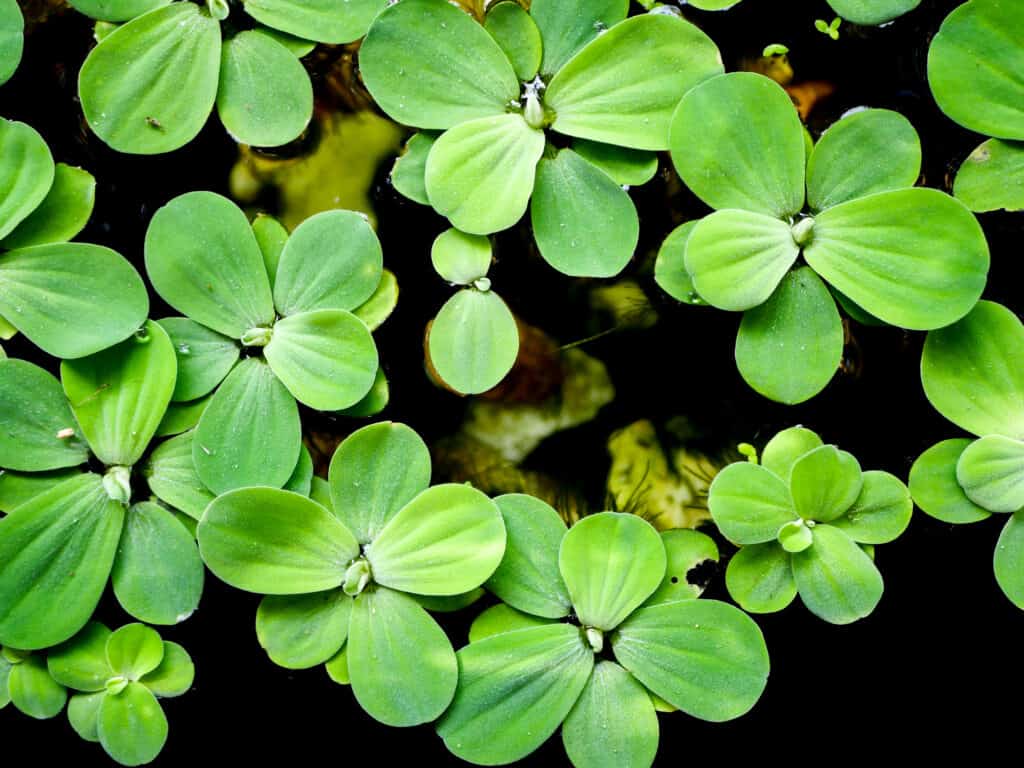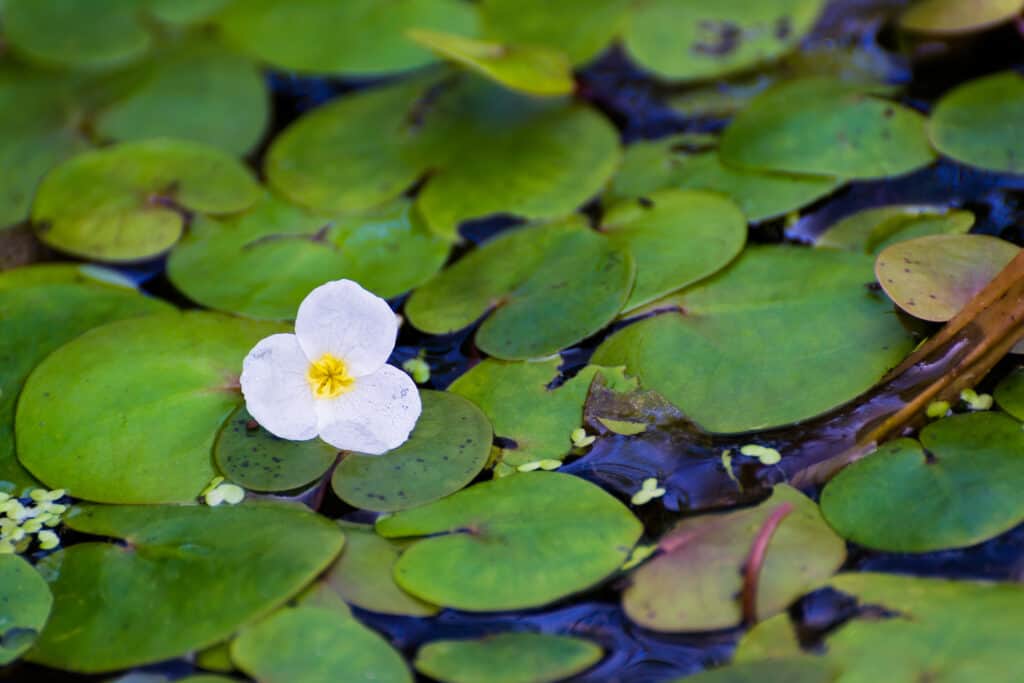Frogbit and duckweed are both floating aquatic plants which both inhabit still and slow moving bodies of freshwater. They are also both widely used as ornamental plants in aquariums and ponds. Both plants have an incredibly similar appearance and are often described as looking like small water lilies. However, they are actually very different and are not even closely related. So join us as we discover everything you need to know about frogbit vs duckweed!
Comparing Duckweed vs Frogbit

| Duckweed | Frogbit | |
|---|---|---|
| Classification | Araceae (family) Lemnoideae (subfamily) | Hydrocharitaceae (family) |
| Size | 0.04 to 0.6 inches | 0.5 to 2.5 inches |
| Leaves | Small, round-shaped | Heart-shaped |
| Flowers | Tiny, green | Small and white |
| Roots | Single short root | Long, covered in fine hairs |
| Growth Rate | Fast | Moderate |
The 4 Key Differences Between Frogbit and Duckweed
The main differences between frogbit and duckweed are the shape and size of their leaves. Frogbit is larger than duckweed and has heart-shaped leaves. However, duckweed has a completely different structure than frogbit. The other differences between them include the color of their flowers and how fast they grow.
Frogbit vs Duckweed: Classification
The first difference between frogbit and duckweed is how they are classified. Despite appearances, they are not actually closely related. Duckweed is the common name for a species in the Lemnoideae subfamily, of which there are approximately 35 species across four genera. Lemnoideae is a subfamily of the Araceae family group which is known as the arum family or the aroids. Although many of the duckweeds are native to the Americas, there are a few species which are native to Africa, Asia, Australia, and parts of Europe.
Frogbit is the common name given to several species of plant within the Hydrocharitaceae family group. The species which are known as frogbit include three in the Hydrocharis genus – H. chevalieri, H. dubia, and H.morsus-ranae – and one in the Limnobium genus – L. spongia (American frogbit). The most common species is the common frogbit (Hycharis morsus-ranae). The frogbits are native to Africa, Asia, Europe, and the Americas.
Frogbit vs Duckweed: Leaves

Duckweed is smaller than frogbit and appears as tiny leaves floating on the surface of the water.
©iStock.com/Polawat Klinkulabhirun
One of the main differences between these two plants is the shape of their leaves. Frogbit often looks like small water lilies as it develops heart-shaped leaves which float on of just underneath the surface of the water. Each individual leaf can be 0.5 to 2.5 inches wide and they are usually a glossy green color, although their underside can sometimes be a little brown.
Duckweed is smaller than frogbit, being only 0.04 to 0.6 inches wide. At first glance duckweeds simply look like small, round-shaped leaves floating around on the water. However, they are not even really leaves at all. Instead, they have a simple structure and consist of a “leaf-like body” with a single root hanging below. This simple structure is typically described as a “thallus” or a “frond”. This small structure often has air pockets which help it to float in the water.
Frogbit vs Duckweed: Root
As we’ve just mentioned, duckweeds are a single, simple structure with a single root hanging below the body of the plant. The root of the duckweed plant is small just like the plant itself. Each frond has a single root hanging just below it in the water. The roots are thin and usually short (although the length depends on the species), and they don’t develop any branches or hairs on them.
Unlike duckweed, frogbit develop roots which are covered in very fine hairs. In many cases the hairs are so fine they are almost impossible to see. The roots of frogbit are usually much longer than those of duckweed and although it again depends on the individual species, in some cases they can reach 20 inches long.
Frogbit vs Duckweed: Flowers

Frogbit develops small white flowers in mid to late summer.
©iStock.com/Mittudomen
The most noticeable difference between frogbit and duckweed is their flowers. Frogbit is undoubtedly the more visually appealing of the two plants as it develops small white flowers. The flowers have a yellow center and consist of three small white petals. Frogbit flowers in mid to late summer, typically during the months of July and August.
Although duckweed is classed as a flowering plant, it does not always flower in the typical sense due to its simple structure. If it does flower at all then the flowers are tiny and green – making it one of the smallest flowering plants around.
Up Next
The photo featured at the top of this post is © iStock.com/tonigenes
Sources
- Plan Your Patch, Available here: https://planyourpatch.com/frogbit-vs-duckweed-what-is-the-difference
- Science Direct, Available here: https://www.sciencedirect.com/topics/earth-and-planetary-sciences/duckweed
- Wildlife Trust, Available here: https://www.wildlifetrusts.org/wildlife-explorer/wildflowers/common-duckweed
- Wildlife Trust, Available here: https://www.wildlifetrusts.org/wildlife-explorer/wildflowers/frogbit
FAQs (Frequently Asked Questions)
Are duckweed and frogbit annual or perennial?
Yes, both are perennial plants which live for more than two years. In most cases they die back during the winter months and enter a dormant state before growing back during the spring.
Are frogbit and duckweed classed as invasive species/
Yes, in many places both frogbit and duckweed are classed as invasive species and a pest. This is because they tend to take over the body of water that they are situated in. As both have a fast growth rate it is possible for them to take over a pond within a matter of days, forming a vast green carpet. When they do this they often cover over the native plants and block out their sunlight. They also use up a lot of the available nutrients which can leave native plants and wildlife lacking be harmful to them.
Are duckweed and frogbit good for bodies of water at all?
Yes, duckweed and frogbit aren’t all bad! For a start, they actually provide excellent hiding places for animals such as frogs, toads, and small fish. They are also a useful place for insects such as dragonflies to land.
Duckweed and frogbit are also widely used in aquariums to aerate the water by using photosynthesis and converting carbon dioxide to oxygen. They are also capable of out-competing algae.
Thank you for reading! Have some feedback for us? Contact the AZ Animals editorial team.






